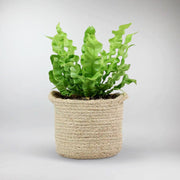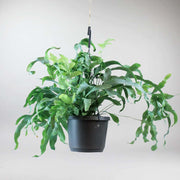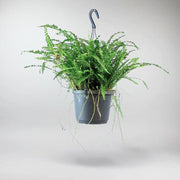Fern Plants
Ferns are nature's living artwork, known for their lush greenery, unique textures, and ability to thrive in various environments. Whether you're a seasoned plant enthusiast or a beginner, fern plants offer a touch of timeless elegance to any home or office space. Our curated collection features a diverse range of ferns, each with its own charm and personality, ensuring there's a perfect match for every décor and lifestyle.
Why Choose Fern Plants?
- Air Purification: Ferns are natural air purifiers, improving indoor air quality by filtering out toxins and adding fresh oxygen.
- Low Maintenance: Most ferns thrive in indirect light and require moderate watering, making them suitable for busy lifestyles.
- Versatility: From hanging baskets to tabletops and wall-mounted displays, ferns fit seamlessly into any space.
- Humidity-Loving: Ideal for bathrooms and kitchens, ferns thrive in humid environments, bringing life to overlooked areas.
Care Tips for Happy Ferns
- Light: Provide indirect or filtered light. Avoid direct sunlight, which can scorch delicate fronds.
- Water: Keep the soil moist but not soggy. Use a well-draining potting mix to prevent root rot.
- Humidity: Ferns love humidity. Mist regularly or place a pebble tray with water nearby for optimal growth.
Shop now and bring the tranquil elegance of ferns into your home!
Indoor Ferns FAQ
How To Take Care Of Indoor Ferns?
With the right care, your indoor ferns will keep rewarding you with their stunning foliage. Although care guidelines vary between different species of indoor ferns, there are some traits that all ferns share.
Humidity
All ferns require ample moisture. If the conditions are too dry for indoor ferns, they will begin to turn brown and drop their fronds. Take care to keep your ferns well hydrated, but not soggy. The soil should be kept damp but not overly waterlogged. Do not let your indoor fern sit in excess water, unless it is a bog fern. Placing the fern onto a tray of damp pebbles can help to optimise humidity, as can regular misting.
Light
In general, ferns are known for growing in the shade of the understory, or in dappled light. That said, indoor ferns still require sunlight for optimal growth. Too much direct light can damage the leaves, but morning and afternoon light will suit most varieties fine. Filtered or dappled light is generally the best option for your fabulous ferns.
How to Water Boston Ferns?
Boston ferns are popular indoor fern plants for the home. Native to humid forests from Northern South America through Mexico, Florida and the West Indies, Boston ferns are particularly thirsty and need plenty of water. Boston ferns have a tendency to drop leaves if they don’t have enough moisture. On hot days they will even enjoy being watered twice!
There is no one rule of thumb for watering a Boston fern, as this will depend on the environment they are kept in. Our top tip for watering would be little and often, and making sure the conditions are right so that your fern plant doesn’t dry out. These shade-loving ferns are easy to care for besides this, so there are plenty of options to keep them happy. Make sure to mist them regularly or place the indoor fern in a humid room, ideally with a tray of pebbles underneath. Keep the soil moist, but not waterlogged. Some experts recommend double potting ferns; placing them into a second, larger pot lined with moist sphagnum moss for retaining moisture.
What Are The Benefits Of Having Indoor Ferns?
The lush green foliage of indoor ferns can enhance the beauty of any room in the house. Many fern plants are evergreens and give year-round displays of verdant fronds. Stylistically, indoor ferns offer a variety of complex shapes and luscious green tones, and make a statement, splaying out magnificently and bringing a forest feel to the home.
Indoor ferns make brilliant houseplants due to their love of shade and ability to grow in a variety of conditions. Ferns can be found in so many different climates that it’s possible to mimic these with the right care or find one that suits your environment. Luckily, despite this huge variety in shapes, sizes, textures, and native environments, most ferns are quite similar in their care needs. They require little maintenance besides regular watering. Some indoor ferns also make great hanging plants and can be strung up artistically around the home, providing plenty of charm.
Most fern species thrive in humid conditions and can make the perfect houseplants for a bathroom or kitchen. Indoor ferns are also known to be fantastic for phytoremediation - removing common airborne pollutants including formaldehyde, xylene, and toluene from the air.
What Are The Best Ferns To Grow Indoors?
The Pleated Bird’s Nest Fern, Asplenium nidus 'Crispy Wave' is a stunning choice of indoor fern plant, with bright electric-green leaves and a wonderful wavy texture. The wavy fronds provide a larger surface for carbon dioxide to be filtered into oxygen, purifying the air more efficiently
The Lace Fern or Asparagus Setaceus is always referred to as a fern, but strictly speaking, is not scientifically a member of the fern family. Lace ferns are actually a member of the lily family, but have the appearance of a fern and require the same care to thrive; plenty of water and plenty of humidity. They are also considered powerfully air-purifying plants.
The Blue Star Fern, or Phlebodium aureum 'Blue Star' make perfect indoor fern plants, with their characterful blue-green hue and elongated fronds. In their natural environment, these ferns grow on the side of trees and are happy in partial shade. Blue star ferns also absorb moisture from the air, rather than just their roots, and make fabulous bathroom plants.
The Boston Fern, Nephrolepis exaltata 'Green Lady' is a popular choice of indoor fern, splaying wildly from its pot. These fern plants look wonderful in a hanging pot and create an eye-catching silhouette. These indoor ferns make great air-purifiers and humidity regulators for the home.
The Asparagus Emerald Fern ‘Sprengheri’ is a sprawling African fern with a truly unique look. Give it plenty of space! These eccentric specimens like to spread themselves out from their pot, and can reach 1m x 1m in size! Not only are these ferns beautiful but they are also very easy to care for.
The Staghorn Fern has a sophisticated look - with gently curved antler-shaped leaves that even catch insects. They can both climb and trail; our staghorn fern at Bloomboxclub comes with an eco kokodama Kokodama coconut bowl pot and matching hanging rope - the choice is yours!
Our Blue star fern, Boston fern and Asparagus Emerald Fern at Bloomboxclub all come with a detachable hanger for the pot, so you can suspend your indoor fern in your favourite spot as soon as it arrives!
How Do I Trim A Fern?
The best time to trim back a fern is before or after the growing season; in early spring or in the autumn. Heavy pruning is not really necessary, but light pruning can help to keep an indoor fern healthy and improve its appearance.
Take some sharp scissors or pruning shears and begin by removing any yellow or brown fronds first. This improves airflow and helps to avoid mould or fungal problems for your indoor fern. You can clean up any oddly-shaped or old-looking fronds, and trim the fern plant to the shape you desire.
Are Ferns Toxic To Pets?
Ferns are generally considered a non-toxic family of plants - but there are some toxic fern varieties. Asparagus ferns are toxic to pets like cats and dogs and will cause sickness if ingested. Other ferns like staghorn ferns and Boston ferns are completely non-toxic and will be fine to be kept around pets. It’s worth researching your particular fern species’ toxicity before keeping it in a home with pets.
Can Ferns Survive In Full Sun?
For almost all ferns, full direct sun in the summer will likely cause leaf-drop, without ample moisture.
Morning light or afternoon light is best, and dappled shade is generally ideal. In winter, your fern plant can be moved closer to a window and will cope with a full day’s gentle winter sunlight. There are different ferns that require different levels of light, so this is just a rough guide. Some indoor ferns like the asparagus fern are not strictly part of the fern family and will require bright, direct light.


































